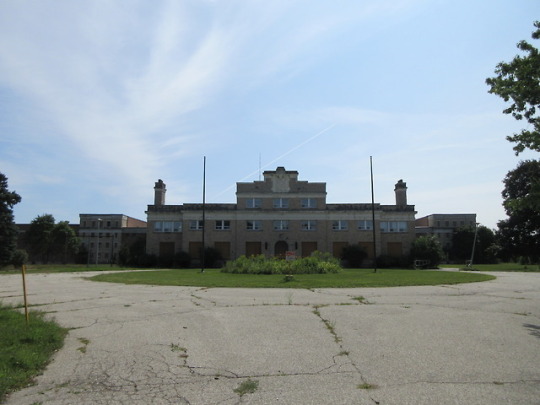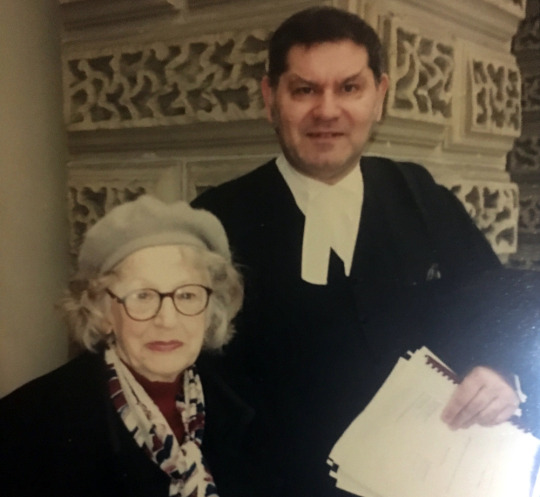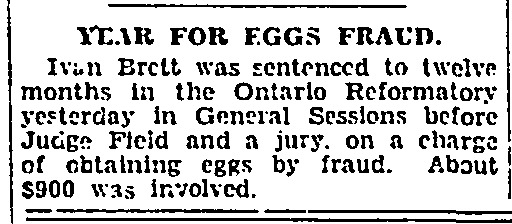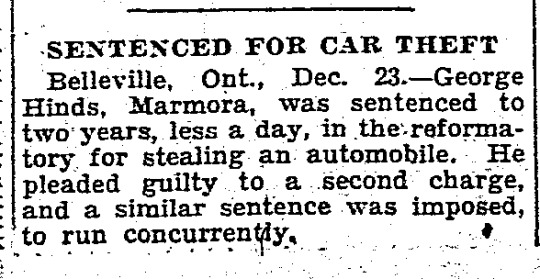#ontario reformatory
Text
“DUFFERIN CO. ASSIZES,” Grand Valley Star & Vidette. November 20, 1930, Pg 1.
---
Jury Throws Out Slander Action—Cattle Thief is Given One Year—Judgment Reserved in Harkies vs. Lord Dufferin Hospital Case:
----
Dufferin County Fall Assizes closed at Orangeville on Friday afternoon, Justice Raney having been on the bench since Tuesday.
The slander action brought by Mrs. Lottie Nixon, of Melancthon Township, against John Wallace, a neighbor, was concluded when the jury brought in a verdict to the effect that the jurors were unable to say which side was telling the truth, and recommended that the action be thrown out and each side pays his own costs.
The case against a young Mono farmer, Arthur Rutledge, charged with theft of three cattle from Hamilton McKim, of Camilla, was commenced on Wednesday. Harry Whittaker, formerly of Toronto, but who is at present servicing a term in Kingston Penitentiary, was the chief witness for the Crown and told of having driven the cattle to the Rutledge farm and then, in company with Rutledge, taking them to a Toronto abattoir and dividing up the proceeds, $139.
One year in the reformatory was the sentence meted out to Rutledge on Friday, the accused having been found guilty of the theft of three cattle.
Counsel in the Harkies vs. Lord Dufferin Hospital case, made three attempts to settle the action out of court, but was unsuccessful and the trial was completed on Friday. Justice Raney reserved his decision but will announce it within a month. The action was brought by Clifford Harkies, father of Ralph, a three-year old infant, who allegedly was severely scalded while a patient in the institution last June. The child was suffering from congestion of the lungs and on orders of Dr. C. I. Scott, steam treatment was applied.
Nurse Dynes swore that the outfit was working efficiently when she left the room. A few minutes later she heard a cry and discovered that the infant had met with the accident.
#orangeville#dufferin county#assizes court#slander#cattle theft#cattle thieves#stolen cattle#sentenced to the penitentiary#kingston penitentiary#toronto#mono township#dead child#scalding#civil suit#great depression in canada#crime and punishment in canada#history of crime and punishment in canada#sentenced to prison#ontario reformatory
1 note
·
View note
Photo

The Dust Off 2022 ***AMMO Doubleheader Weekend*** Tomorrow!!! The Dust Off 2022 will be held in the parking lots of BW3 in Ontario, OH. This is our one time a year event where fellow Mopar enthusiasts can meet up and hang out for the day. The Dust Off will be Saturday, May 14, 10am-2pm with BW3 reserving space for us to have lunch. 🚘🚘 Meet-up: 8:45am Quaker Steak & Lube, 8500 Lyra Drive, Columbus, OH 43240 🚘🍗 Rollout 1: 9am (sharp) Buffalo Wild Wings 949 N Lexington-Springmill Rd, Ontario, OH 44906 Within 3 miles of the event are about 15 other restaurants for a different option also. Around 2pm we will cruise up to the Mansfield Reformatory for some great photo ops and you will have an opportunity to take a tour of the prison if you wish. The prison closes at 4pm so if you'd like to go earlier, that is fine also. 🚘🚘 Rollout 2: 2pm The Ohio State Reformatory 100 Reformatory Rd, Mansfield, OH 44905 **Absolutely No Burnouts or Excessive Speed ammocarclub.com #Ohio #ammocarclub @byersauto @hinderercdjr #HEMI @stellantisna @automedicssouth @hotshotssecret @pantherlights @toxsickcreations #OH @thetintlabusa @bpreciseautodetailing #dodgegarage @jaxwaxcolumbus @jaxwaxcarcareproducts @chrysler @ramtrucks @dodgeofficial @jeep @officialmopar @michaels_auto_and_performance @marktoeniskoetter @sco4x4 #soundinvestment #Mopar #OhioMopar #TheDustOff #TheDustOff22 #TheDustOff2022 #mansfield @neohiomopar @midohiomopars (at Ontario, Ohio) https://www.instagram.com/p/Cdf5iNrrciu/?igshid=NGJjMDIxMWI=
#ohio#ammocarclub#hemi#oh#dodgegarage#soundinvestment#mopar#ohiomopar#thedustoff#thedustoff22#thedustoff2022#mansfield
3 notes
·
View notes
Photo


The former Ontario Reformatory.
Pictures taken on
August 28th, 2017.
January 20th, 2018.
Taken on a Canon PowerShot ELPH 360 HS.
#guelph#guelph correctional centre#abandoned#Abandoned building#abandoned jail#ontario reformatory#Abandoned Ontario
6 notes
·
View notes
Text
Remembering Velma Demerson: Grand soul, feminist, human rights advocate and writer

[Velma Demerson was jailed in 1939 and by the Ontario government for the "crime" of having a Chinese boyfriend; sixty years later, she began an ultimately successful legal challenge seeking reparations; I'm pleased to present this remembrance for Demerson by Harry Kopyto, the campaigning human rights lawyer, who served as one of her advisors -Cory]
On Monday May 13, 2019, Athena Mary Lakes, better known as Velma Demerson, died from old age in a Vancouver hospital at the age of 98. She is best known for her successful legal battle culminating in 2002 against the Ontario Government for incarcerating her in Toronto in 1939 for almost a year. The reason for her incarceration? She was found morally “incorrigible” under the Female Refuges Act for living with a Chinese man, Harry Yip, whom she married after her release. Their son, who was born while she was in jail, was taken away from her until after her release.
Velma returned to Toronto in the late 1990s after living half a century on the west coast. While there, she married and raised two children. Her implacable sense of injustice led an unstoppable Velma Demerson to storm back to Toronto to quench her thirst for justice. After being rejected by a slew of Toronto lawyers, eventually she found Harry Kopyto who initiated a legal claim arising out of her imprisonment and turned a room in his office into a defence committee centre. Gradually, her case drew widespread public attention and support including from the leaders of all Ontario’s political parties at that time, the women’s movement, academics, the organized labour movement, the Chinese community and many individual human rights activists such as David Suzuki.
Some of the lawyers that she first approached ridiculed the prospect of initiating a lawsuit 60 years after a limitation period expired. However, Velma drew on support from a pugnacious legal team and a defence committee that issued newsletters, raised funds for legal expenses, publicized her case widely in the media and organized rallies, panel discussions and similar events. Many young people who heard her story could not believe it was true.
Despite the broad support and even outrage of many members of the public, the Ontario government resisted compensating Velma on the basis of the extraordinary lengthy delay of her legal claim. However, her lawyers soon concluded that the Female Refuges Act, under which Velma was jailed was in fact disguised criminal law with the power to jail children as young as 16 for up to two years. Accordingly, the Act was outside the legal jurisdiction of Ontario to enact. Her legal team realized that if they sought a declaration from the Court to that effect, their claim would not be subject to any limitation period at all! As a result of using that strategy, even though it might not offer her compensation, her supporters felt the Government could no longer oppose her claim once a judge declared the Act unlawful. The Ontario Government caved in when they realized their vulnerability.
There was massive support for her when the matter was raised in the Ontario Legislature. The Conservative government quickly settled her case with the Attorney-General and premier personally making an official apology.
The law that allowed Velma to be jailed, along with 15,000 other young women, was crafted at the beginning of the last century by racist promoters of eugenics. was seen as indefensible by any current standards. Even though the Female Refuges Act was abolished in 1964 because of desuetude (lack of use), almost none of the other victims incarcerated under the Act—many impoverished, emotionally drained and defeated by their abusive treatment—fought back despite Velma’s efforts to encourage those still alive.
Ms. Demerson was 18 years old at the time of her imprisonment (1938) in the Belmont House and the Mercer Reformatory for Women when the development of massive washing machines to clean the local hospital laundry washed until then by the Belmont House’s inmates made their free labour unnecessary, so they were packed into a fleet of taxis in the heart of darkness after midnight and ferried downtown to the Mercer Reformatory. There she was subjected to involuntary medical tests and injections and to rules of silence. The Mercer, which was ruled by a Superintendent committed to eugenics, was closed after a Grand Jury expressed shock at its dangerous and dungeon-like and inhumane conditions in the 1960s. In 2002, Velma received the J.S. Woodsworth Award from the Ontario NDP for her promotion of human rights and equity. Velma toured schools relating her ordeal to shocked students, spoke passionately at an Ontario Legislative Committee hearing on prevention of child prostitution, was a featured speaker at various conferences and advanced the rights of a vast parade of vulnerable people with her perspective of never giving up.
Velma was highly admired by everyone who met her. She laughed easily, was almost always positive, although sometimes irascible and was fiercely independent up to the time of her death. She wrote three books during her lifetime, two of which, Nazis in Canada published in 2017 and Incorrigible, published in 2004, were based on her experiences.
As one of her supporters and legal advisors, I recall, a few months after her legal victory, financial settlement and apology, Velma perched on the very top of a red firetruck rolling along in the Labour Day Parade in Toronto in 2003 greeting her admirers with a triumphant smile.
Velma’s struggle was motivated by her desire to set an example to others as well as to right an historic wrong against herself and victims of bigotry. She showed that through relentless struggle and solidarity, the most unlikely goals can be achieved. Her life has touched the souls of many.
https://boingboing.net/2019/05/29/justice-delayed-not-denied.html
17 notes
·
View notes
Text
What Happened to Harold McLean?
What Happened to Harold McLean?
November 26 1933
Lanark County Judge. J. H. Scott on Wednesday, sentenced Harold (Bunk) McLean, of Perth, found guilty of breaking and entering and theft of a lantern, to 12 months’ determinate and 12 months’ indeterminate in the Ontario Reformatory, at Guelph.
A further charge of arson against McLean was dismissed. Both charges arose following the destruction by fire on September 21 last; of…

View On WordPress
0 notes
Text
Americans, go home: Tension at the Canada-US border
Image copyright
Getty Pictures
Image caption
The Peace Arch used to be erected in 1921, to commemorate the Treaty of Ghent, which ended the War of 1812
As the pandemic continues to brush the US, Canadians are getting an increasing number of captivated with what American company shall be bringing with them over the border.
Built directly on the border of Blaine, Washington and Surrey, British Columbia, the Peace Arch is a 67-foot excessive (20 metres) testament to the finish ties between Canada and the US.
Inscribed on one aspect are the phrases “May well simply these gates by no methodology be closed”, a reminder of the simply about 8,891 km (5,525 miles) of un-militarised border that separates the two nations.
For nearly 100 years, these phrases were heeded – till the coronavirus pandemic successfully shut the border indefinitely.
The closure came into operate on 21 March, and used to be agreed upon by every governments. After being prolonged quite loads of cases over the summer season, it stays in operate till 21 August – though most count on it to be prolonged but again.
“I by no methodology understanding I would be sitting right here mid-August and that border continues to be closed,” says Len Saunders, a dual citizen who lives in Blaine.
“It unswerving appears to be dragging on and on and on with no cease in sight.”
Whereas the border closure has had basic economic and inner most repercussions for the tens of millions of these who’re dwelling along it or maintain cherished ones on the more than a few aspect, the overwhelming majority of Canadians want it to cease shut.
Image copyright
AFP by the usage of Getty Pictures
Image caption
The US-Canada border has been closed since March
A July ballotby Ipsos Reid came all the procedure by that eight in ten Canadians wanted the border to cease closed till no decrease than the cease of 2020.
And because the pandemic has persisted to spread all the procedure by the US, so maintain tensions between American drivers and Canadian residents.
Whereas non-very basic experience back and forth is forbidden, commercial drivers turning in goods and these that work all the procedure by the border in very basic products and services are accredited to frightful.
Other folks with American licence plates maintain reported being careworn and having their autos vandalised, even in the event that they’ve every lawful to be on the Canadian aspect.
Mr Saunders, an immigration attorney who has many patrons who frightful the border on a typical foundation in suppose to work, says many contributors are afraid.
“They’re all greatly surprised of driving their autos in the decrease mainland thanks to vandalism, dirty appears to be like and unswerving getting treated as some ‘frightful American’,” he informed the BBC.
One in every of his prospects, an architect who used to be allowed to practise in Canada for the duration of the shutdown, says he used to be informed to “return dwelling” thanks to his vehicle.
The tensions are so excessive that British Columbia Premier John Horgan instructed that Canadians with American licence plates must bag the bus or tear bikes as an replace.
In the Muskoka location of Ontario, where many contributors maintain summer season homes, the hostility has garnered police consideration.
Ontario Provincial Police dispute a Canadian in town of Huntsville filed a complaint after two men allegedly accosted him over his Florida licence plate.
“Most lately this weekend, there used to be a gentleman up in direction of Huntsville getting gasoline in his vehicle, and two gents approached him and acknowledged, ‘it’s possible you’ll maybe well perchance be American experience dwelling.’ And he acknowledged, ‘I’m Canadian. I are dwelling right here.’ And so that they actually acknowledged, no, we produce now not imagine you point to us your passport,” Phil Harding, the mayor of internal reach Kuskoka Lakes, informed CP24.
“It unswerving turns into somewhat bit aggressive, and they terror for his or her lives somewhat bit.”
Tightened border security has also led to a pair distinguished arrests.
In Abundant Forks, British Columbia, the Royal Canadian Mounted Police spent over two hours chasing a man, who allegedly had crossed illegally in a stolen vehicle on 24 July, down a river. The “experience in conjunction with the drift crawl” ended where the river narrowed, when police, with the support of bystanders, were in a situation to wade into the river and escort him wait on to shore.
Image copyright
RCMP
Image caption
The ‘experience in conjunction with the drift crawl’ suspect
Costs are pending, but anyone caught breaking the border restrictions can even be fined up to C$750,000 ($566,000; £434,000) and be sentenced to six months in reformatory, or C$1m and three years if their actions “scheme off threat of impending death or excessive bodily wound”.
Those hefty fines are now not unswerving for wilful rule-breakers.
On Wednesday, police warned American citizens collaborating in an annual experience in conjunction with the drift down the St Claire River strategy the Michigan border that even accidentally crossing into Canada may maybe maybe well result in a hefty swish. In 2016, for the duration of additional carefree cases, Canadian police congenially escorted about 1,500 floaters wait on to the US aspect after winds blew them off beam.
Aloof, the results of the border closure on the cramped towns along either aspect have to now not insignificant.
Sooner than coronavirus, around 300,000 folk crossed the border every single day, in conjunction with Canadians who mechanically made daytrips to score a deal at US outlet malls or petrol stations, and American vacationers exploring the surprise of Niagara Falls.
Since March, non-commercial land border crossings to Canada maintain dropped by simply about 95%, in step with the Canadian Border Services Agency (CBSA).
“It be going to decimate all the pieces up there,” Mr Saunders says.
Nevertheless the commercial influence of closing the border to travellers is nothing when put next with what would occur to Canada if one other wave of coronavirus forced a second shutdown, says Ambarish Chandra, a professor of economics at the College of Toronto.
“This experience back and forth does maintain quite loads of economic influence on the communities where travellers experience to,” he says.
“Nevertheless given the pandemic in the US, and the replace of cases there, it makes sense to ban experience back and forth to the US – potentially indefinitely.”
Prof Chandra says government must give aid to frame towns whose economic system relies carefully on foreign tourism, but defend actual with the border closures till the pandemic is over.
“In the long term it be system more cost effective to bail out all of Niagara Falls, Ontario, than to finish down Toronto for even one other three or four weeks,” he says.
After months of shuttering most firms, Canada’s coronavirus cases are shedding and the nation is in the guts of re-opening its economic system. Each day cases maintain dropped from a excessive of two,760 on 3 May well simply to a pair hundred.
Eating areas and retail outlets were originate for at least a few weeks in most significant cities, and to this point, cases are tranquil trending downwards.
Meanwhile, the US is attempting to tame its outbreak, which reached a top of 75,821 on 17 July and is seeing about 40,000 fresh cases a day.
Coronavirus: US vs Canada
Those numbers are what’s fuelling the unease many Canadians maintain with American travellers.
“Montana is directly south of us, is having a second spike of cases lawful now, and I produce now not feel sorry for any one which will get stopped at the border, let’s attach it that system,” says Jim Willett, the mayor of Coutts, Alberta.
“I’m afraid if we opened up the border too soon, we would maintain extra of a enviornment admire what’s happening down south.”
His town is one in all the 5 border towns where US residents travelling to Alaska can enter Canada, since the CBSA cracked down on the so-called “Alaska loophole” at the cease of July.
Since Alaska shares no borders with assorted US states, American citizens want to drive by Canada, hence the “loophole”.
After the border closed, many maintain expressed effort that drivers were exploiting the loophole to explore some of the nation’s most scenic areas, admire Vancouver Island and Banff, Jasper, and Lake Louise.
In June, RCMP issued seven tickets price $1,200 ($906, £694) every to American citizens who broke the foundations by sightseeing in Alberta.
“Construct now not experience experience. Trot directly to Alaska,” Premier Horgan acknowledged for the duration of a news conference in July.
Image copyright
Getty Pictures
Image caption
American vacationers were spotted in scenic spots admire Banff Nationwide Park, despite the border closure
Complaints relating to the loophole and the shortcoming of enforcement led to the crackdown.
On the cease of July, the border authority presented that Alaska-certain travellers had finest little parts of entry, must bag the most enlighten route to their vacation situation, and may maybe maybe well also advise tags in their vehicle figuring out them as US drivers going to the northern stammer.
They also are little to a “cheap duration of cease” in Canada, and are forbidden from visiting nationwide parks, leisure sites and various tourist destinations, with rule-breakers going by the stiff penalties.
For the reason that tougher principles were enacted, Mr Willett says he’s now not “too alive to” relating to the web explain visitors coming over the border.
“[We] bag a entire lot of folk by all cases of the day and evening. Most of them are somewhat co-operative,” he says.
from WordPress https://ift.tt/3akkoFK
via IFTTT
0 notes
Text
INKCARCERATION Music and Tattoo Festival Returns to Historic Ohio State Reformatory July 12-14, 2019; Daily Music Line-Ups Announced, with Shinedown, Godsmack and Five Finger Death Punch Set to Headline

The INKCARCERATION Music and Tattoo Festival recently announced its return to the historic Ohio State Reformatory, a.k.a. Shawshank Prison, in Mansfield, OH, on July 12, 13 and 14. This year's massive line-up will be led by none other than colossal rock bands Shinedown, Godsmack and Five Finger Death Punch. Quickly becoming one of the nation's premier rock festivals, INKCARCERATION will feature over 30 bands on two outdoor stages, 70 tattoo artists, reformatory tours, gourmet food trucks, the best drinks and for the first time, the haunted house attraction, Escape from Blood Prison.
INKCARCERATION has revealed the festival's individual daily line-ups! In addition, single day tickets are now on sale.
Daily Lineups:
Friday July 12th:
Shinedown, Taking Back Sunday, Skillet, Fozzy, Red Jumpsuit Apparatus, Awake at Last, The Funeral Portrait, The Everyday Losers
Saturday July 13th:
Godsmack, +Live+, Motionless in White, Red Sun Rising, Buckcherry, Andrew WK, Stabbing Westward, Light the Torch, Eyes Set to Kill, Raven Black, Impending Lies, Monster Dolls
Sunday July 14th:
Five Finger Death Punch, Seether, I Prevail, Starset, P.O.D., From Ashes to New, Smile Empty Soul, Kerbera, Beyond Unbroken, Rivals, Monster Dolls
INKCARCERATION Music and Tattoo Festival's incredibly unique festival setting - the historic Ohio State Reformatory - is considered one of the most haunted buildings in the country and is the setting of the 1994 cinematic classic/IMDB's highest rated movie of all time, The Shawshank Redemption (celebrating its 25th anniversary this year). The Ohio State Reformatory is centrally located about an hour away from Cleveland, Columbus, and Canton/Akron, Ohio and within a three-hour driving distance of Toledo, Dayton, Cincinnati, Youngstown, Pittsburgh, Pennsylvania, northern West Virginia, Michigan and southern Ontario. Additionally, INKCARCERATION features tent and RV camping for a true outdoor festival experience!
With the concert happening outside, INKCARCERATION will feature 70 local and regional tattoo artists tattooing all weekend inside the reformatory. Appointments are recommended if there is a specific artist you would like to work with. Visit www.inkcarceration.com/tattoo for information on how to book your appointment and to see a full list of featured tattoo shops, companies and artists. Tattoo competition details and judges will be announced soon.
Escape from Blood Prison is the annual Halloween haunted house attraction hosted at the historic Ohio State Reformatory in Mansfield, OH. It typically runs from the end of September through early November every year, but INKCARCERATION will make this spooky attraction available for festival goers to experience all weekend long in 2019! Once Blood Prison takes over the reformatory, the enormous facility is filled with bloodthirsty inmates waiting for victims to enter and try and make it through the facility alive!
Single Day General Admission (Early Bird)
ONE General Admission Wristband includes:
- Field pass for concert
- Access to the tattoo convention
- Self-guided reformatory tours
Starting at $65
Weekend General Admission
ONE 3-day General Admission Wristband includes:
- Field pass for concert the entire weekend
- Access to the tattoo convention
-Self-guided reformatory tours
Price $199




















Photos by Jordan Buford Photography
#INKCARCERATION Music and Tattoo Festival 2019#INKCARCERATION Music and Tattoo Festival#INKCARCERATION Music and Tattoo Festival The Music Enthusiast#INKCARCERATION Music and Tattoo Festival Info#INKCARCERATION#INKCARCERATION 2019#INKCARCERATION The Music Enthusiast#The Music Enthusiast#2019#Dallas#Texas#Mansfield#Ohio#Music#News#Dallas Music Blog#Texas Music Blog#Shinedown#Taking Back Sunday#Skillet#Fozzy#Five Finger Death Punch#Godsmack#Red Sun Rising#Seether#Music Enthusiast
0 notes
Text
Day 18 - 25th June 2017 Berlin Ohio
“ Welcome to the Sovereign lands of the Senaca Nation “
I opened my eyes suddenly and through the gap in the curtains I saw the sun rise over Niagara Falls, beams of sunlight ricocheting across the water.
We had breakfast overlooking both Falls in the main dining room and were ready to hit the road later than normal.
It was a real feat of ingenuity in trying to get our luggage from floor 22 to the lobby.
With the amount of cases we have in tow you would not be wrong in assuming we were staying for a month, not just overnight. The thing is that none of the stuff actually fits back into the suitcases.
It's not as if we have bought tons of souveniers, because we haven't, if anything we have got rid of a few things, however our clothes seem to be getting bigger and our cases smaller.
The Canada / USA Border Control saw fit to close the Rainbow Bridge linking both countries, as you can imagine the temperamental SatNav was beside itself, it started spitting out all sorts of directions, “ turn right, turn left, move to the right, do a U turn” I'm sure it started to screech with frustration.
Finally we decided to stop and re programme it, no change it still spouted out a furious volley of instructions.
We had no choice but to go with it and ended up on the way to Ontario.
Finally after about 20 minutes , the road veered West and we slammed straight into a queue waiting to cross into the USA, which we finally did after a long wait and Whcky Races part two, as everyone slammed their cars into first and frantically tried to be the first to the three Control posts that were open.
We accelerated out of Canada and into New York State, picking up speed on the Interstate and passing into The Seneca Reservation, which frankly looked much the same as everywhere else and then into Pennsylvania.
Miles rolled into miles, the weather was a bit indifferent, sun and rain, rain and sun.
Our destination was the Ohio State Reformatory, the setting for the film The Shawshank Redemption
We turned the corner and there it was in all its its beautiful glory.
The building is magnificent and it's very hard to believe that it used house a prison, from the outside it could pace for a French Chateaux.
It has been closed now for a number of years and Hollywood has moved in, however walking through it you can still get a sense of its history, looking through the bars in “ Solitary” I could feel the anguish of the poor souls punished in there, the inhumane way in which they were treated as they were locked in there , either in total darkness or in bright lights for the duration of their stay.
The cells were tiny and could house up to four inmates, all of them living in cramped conditions, is it any wonder fights broke out, relationships were formed and enemies made.
We saw “ Andys “ escape tunnel and the sewer in which he made his bid for freedom ( by the way the “sewage” was made up of chocolates and crackers )
It was an interesting two hours as we roamed about on a self guided tour of this massive structure, wands in hand as we listened to snippets of information and learned paranormal happenings ( one guy set himself alight in one cell, I took a quick snap in the hope something might show up ).
Outside the world was normal, a game of baseball was being played in the grounds and geese roamed by a large man made pond.
We stopped in Canton for an early meal and drove o to Berlin, the home of the largest Amish population in the world.
It was as if a switch had been flicked as we entered into Holmes County, we saw pony trap after trap, carrying families home from church, these ladies and gentlemen were dressed in their finery, their horse clipping along elegantly, their tack shiny in the sun.
In front yards families were sitting together, playing together and enjoying a Sunday off.
As it is the Sabbath everything is closed here, that's why we had to grab a bite to eat early in an another County, but the peace is wonderful, it's a shame we are on a our way again tomorrow.
0 notes
Photo

People with traumatic brain injury approximately 2.5 times more likely to be incarcerated
People who have suffered a terrible brain injury are around 2.5 times more most likely to be jailed in a federal correctional facility in Canada than people who have not, a brand-new research study has actually found. “These findings contribute to emerging research suggesting traumatic brain injury is a crucial threat element for involvement with the criminal justice system,” said lead author Dr. Plants Matheson of the Centre for Urban Health Solutions of St. Michael’s Health center and an adjunct scientist at the Institute for Scientific Evaluative Sciences. “This might be simply the pointer of the iceberg as our study focused only on people with more serious TBI,” she stated. “We likewise did not consist of people who may have served time in provincial, instead of federal jails.” The research study was released online today in CMAJ Open, the open-access journal of the Canadian Medical Association Journal . The authors stressed that the overall danger of somebody who has experienced TBI being jailed was still low, at less than 5 in 1,000, compared with less than 2 in 1,000 for individuals without a history of TBI. Nevertheless, understanding that individuals who are put behind bars are a lot more most likely to have actually experienced brain injury than the general population will assist health-care companies much better identify individuals at danger for imprisonment and supply much better take care of people within the prison system.The researchers determined nearly 1.42 million grownups ages 18-28 who were eligible for healthcare in Ontario on July 1, 1997, and followed them to the end of 2011. The age group was selected due to the fact that of its high risk of TBI and participation in the criminal justice system.Their health information, consisting of previous TBIs, was gotten from emergency and healthcare facility records kept at ICES, and connected to incarceration records held by the Correctional Service of Canada.Of the 77,519 people with a history of TBI, 402 were put behind bars during the 14-year duration, a rate of 0.5 per cent. This was more than double the rate of people without any history of TBI(3,331 people from 1,401,887, or 0.2 percent). To analyze the effect of the issue more plainly, Dr. Matheson and her team even more broke down the numbers to take a look at the rate of imprisonment, taking into consideration the number of brand-new cases and years invested put behind bars for each group throughout the study period.The scientists found imprisonment was 2.47 times higher in men who had sustained a TBI prior to being incarcerated in a federal reformatory compared to males who had not.For ladies, incarceration was 2.76 times higher for those who had suffered a TBI in contrast to women who did not suffer a TBI. Nevertheless, the scientists did note that the variety of incarcerated ladies with TBI was small– 17
0 notes
Photo

“Year For Egg Fraud,” Toronto Globe. October 15, 1932. Page 11.
----
Ivan Brett was sentenced to twelve months in the Ontario Reformatory yesterday in General Sessions before Judge Field and a jury, on a charge of obtaining eggs by fraud. About $900 was involved.
#toronto#sessional court#fraud#obtaining goods under false pretences#eggs#egg theft#stolen eggs#sentenced to prison#ontario reformatory#great depression in canada#crime and punishment in canada#history of crime and punishment in canada
2 notes
·
View notes
Photo

“‘Rather Lose Leg Than Go To Pen,’ Police Quote Him,” Toronto Star. August 7, 1942. Page 2.
----
Richard Dickenson, Shot by Detective, Objected to Having Bullet Removed
---
ELECTS JURY TRIAL
---
A Police Court, City Hall, Magistrate Gullen
Facing charges of having two loaded revolvers, burglar’s tools, theft, and receiving of a motor car and receiving two picks and crowbars, Richard Dickenson elected trial by a jury. He was committed.
Kenneth Green and Sidney Birt, jointly charged, were committed for trial last week.
B. A. Pennock stated his car was stolen from Dovercourt Rd. July 11.
‘Det.-Sergt. Richardson and I were on Landsdowne Ave about midnight July 18,’ testified Det. H. Hodgson. ‘We saw the car that had been reported stolen in a vacant lot. While Det.-Sergt. Richardson was parking the police car, I took up observation on the stolen car. In a few minutes three men approached the car and entered. I recognized Green and Birt, I could not identify the third man.
‘They saw me and ran. I fired one shot. They ran up a lane and got away Green and Birt were picked up shortly afterwards. Searching the car we found the burglar’s tools and loaded revolvers. The revolvers were wrapped in a handkerchief with a laundry mark 103,’ the detective said.
Det.-Sergt. J. Nimmo related visiting the home of Dickenson Aug. 1. ‘I examined his leg and found a wound at the rear of the left leg. Det. Ed Tong and I took him in a hosital and had him examined. They found a bullet in his leg. He refused to have it taken out. I told him that he might lose his leg. He replied that he would rather lose his leg than go to Kingston. Later he admitted that he was wounded about two weeks previously when chased by a police officer,’ Nimmo stated.
Det.-Sergt. Richardson stated he saw accused Aug. 1. ‘The shirt he was wearing had the laundry mark 103 as did a handkerchief he had. This was the number on the handkerchief found in the stolen car,’ witness concluded.
‘This is not a case for probation. You have a record, and stealing from one’s employers is a serious offence. No restitution has been made,’ said the Magistrate in A court, in the case of Clifford W. Clifford, appearing for sentence on a charge of stealing about $200 from a dairy firm.
He was sentenced to four months definite and three months indefinite. Evidence was given at a previous hearing.
In the case of Edward August who pleaded guilty of receiving milk tickets knowing them to have been stolen, his worship said it was a mean thing to do. August was given suspended sentence and put on three months’ probation.
‘I wish to point out accused was in the army and discharged as medically unfit,’ said Crown Attorney Malone.
Detective John Standing related finding seven milk tickets on accused belonging to different dairies. ‘He told me he bought them from a boy,’ said witness.
Ben. SIlver pleaded guilty of recording and registering bets in a house on Harbord St. and was fined $200 or two months and was sentenced to serve 15 days.
‘Entering the place with other officers I found three sheets of paper with bets totalling $950,’ said P.C. John Mullin.
#toronto#police court#carrying a revolver#receiving stolen goods#burglars' tools#theft#police shooting#shoot out with police#shoot out#fleeing suspects#shot in the leg#sentenced to prison#ontario reformatory#suspended sentence#probation#kingston penitentiary#illegal betting#canada during world war 2#crime and punishment in canada#history of crime and punishment in canada#fines or jail
1 note
·
View note
Text
“From ancient times in has been presumed that prisoners would be given employment when this was profitable or convenient to their captors. They have been put to work in gangs on public buildings, roads, in the galleys and elsewhere, as this has suited public convenience or profit, or for the purposes of punishment. Benefit or advantage to the prisoner has rarely, until recently, been considered; in fact, his treatment has often been directly contrary to his good. Idleness was the lot of many, only relieved by the treadmill or similar contrivances for the carrying out of the sentence which included the phrase "with hard labour." In the county jails of Ontario, apart from cooking, cleaning, etc., idleness is the rule, though in winter, snow may be shovelled, and in the summer some road-making and gardening may be done, and in two or three jails some other work is carried on for the counties concerned. Of course in this Province the jails are merely used for temporary detention or very short terms.
During the last half of the past century in Great Britain, the United States, Canada and elsewhere, work was increasingly alloted to prisoners for the triple purposes of lessening the cost of maintenance to the taxpayer, the improvement and upkeep of the property, and also for the health of the prisoner, the idea of work as punishment operating less and less except in rare cases. Fifty years ago, prison labour was (and is even yet, in too many of the American States, about twenty) let by contract at a small sum per day which was devoted to reducing the cost of prison upkeep. This had certain financial advantages to the state and showed that many prisoners could be productively employed, but the objections to it are very serious and the pressure of enlightened public opinion and of free labour is compelling governments to discontinue it. However, it is clear that with the passing of the contract system other work must be devised for prisoners to save the cost of upkeep of institutions and to prevent the degenerating results of idleness. This is a problem that is now acutely faced in the United States since the passing of the Hawes-Cooper Bill, which in a year or two will practically eliminate contract prison labour in the United States. The prison contract system has not been in operation in Ontario for many years.
But an additional object in the employment of prisoners has for some years been demanded by an increasing section of the public. Until recently, the prisoner’s family or dependants could go to the devil so far as the public cared. Officialdom certainly no interest. The man had broken the law and had to be punished by imprisonment. If his dependants suffered it could not be helped. Friends, philanthropic agencies, churches and municipalities might help the innocent dependants if they pleased, but it was held that the punishment of the prisoner must not be lessened nor the burden to the state increased because others were suffering also. The fallacy of this contention eventually became so clear that in a number of the states of the American Republic, experiments were made in the employment of prisoners at productive labour and the crediting of "wages" to the prisoner for his dependants. After a good many years of trial this payment of "wages" has practically become a settled policy in some institutions.
There are, however, some serious difficulties and objections to it. If F. and P. have wives and families and are both out of work and in want, and P. finds that by committing a crime, he may be successful in getting money, or if unsuccessful, he and his family are supported by the state, will not F. be tempted to follow P’s example, or feel grave injustice at the spectacle of a lawbreaker and his family being aided while honest persons are left to suffer? Furthermore, while it is clear that the state could, if it wished, pay a bonus or gratuity to anyone, and while it may be reasonably contended in certain cases that such a bonus or gratuity should be paid out of the public funds to the dependants of prisoners, a real wage can only be economically sound and possible if it is a fair recognition and return for actual net value given. Whether and what wages can be paid to prisoners will depend, therefore, mainly on the following:
The prisoner's physical and mental ability and his attitude.
The availability of employment suited to his abilities.
The length of the term for which the prisoner will actually remain inside the institution and at a particular job which he has been trained to perform efficiently.
The market and demand for his products.
The cost of handling the product.
The cost of housing, feeding and custody; and depreciation and repairs of building and equipment.
The interest on capital invested in the plant and material.
Possibly the first item is the most important but all are closely related. On them all depends whether a wage can be economically paid and if so, how much, or whether the defects and unfortunate attitude of the prisoner and the overhead charges are such that he is and will remain a financial loss to the institution.
An examination of the annual reports concerning the persons committed to the five Provincial Reformatories or Industrial Farms of Ontario and to the two Toronto Municipal Farms show that about 10% could neither write nor read, about one-third had no trade, and a large number of others who were classed as mechanics or agriculturists were not really skilled workers at all. In other words the great majority of the inmates of our institutions are practically untrained and their economic value is by no means high, even as free men.
After a good many years' association with prisoners, though I have found many very likeable men among them, some highly capable and intelligent, and not a few decent and in many respects reliable; I think it is safe to say that a large number are not dependable (for mental, moral or physical reasons) and the great majority are not economically of very great value, being untrained, and not having the right attitude toward public service. It would, I believe, be safe to say that of the prisoners mentioned in the Deputy Provincial Secretary's reports, two-thirds lack the ability and attitude which would make the payment of wages to them economically possible under any practicable internal custodial conditions, and when the actual intra-mural custodial conditions are taken into account the number which might possibly be paid wages on a sound economic basis is still less. Another important feature of the problem is that usually over half of those convicted in a year in Ontario are given sentences of three months or less and an increasing number receive indeterminate sentences.
These facts, without any others, show how difficult it would be to attempt to pay wages to non-penitentiary prisoners in Ontario on any sound basis except in occasional cases. The problem of penitentiary long-term prisoners is, of course, another matter, not am I here dealing at all with the question as to whether the province should undertake to assist the dependants of its prisoners out of the public purse. That is also another matter and would involve a revision of a past policy which places dependents upon municipalities rather than upon the Province. However, the Ontario Extra Mural Employment System with which this report deals is based upon the assumption that whether the payment of gratuities to dependants of prisoners is proper or improper, it is certainly undesirable if it can be avoided.
In the Provincial institutions of Ontario a creditable effort has been made to use the labour of inmates to the physical and mental advantage of prisoners and public. In the Ontario Reformatory at Guelph for example, work is done each year by prisoners in weaving, farming, packing, canning and turning out other products to be used by provincial institutions, which reduces the expense of upkeep by three or four hundred thousand dollars. A very creditable figure indeed. But the full aggregate annual cost of that reformatory is twice that sum. This showing of such a well-managed institution demonstrates the practical economic difficulties in the way of paying wages to intra mural prisoners. If reformatory products were more extensively used by provincial departments which now buy from the regular markets, the taxpayers would undoubtedly benefit; but even then the feasability of a general payment of wages would be by no means sure. If certain industries in the reformatory, such as the abattoir at Guelph or the Brick and Tile Plant at Mimico for example, and certain selected inmates were alone to be considered, the matter would be somewhat simpler and less difficult of solution. It might be worth while to make a definite experiment of a "one industry" place like Mimico for a few years as a wage-paying institution, with carefully selected prisoners. But the full institutional overhead of the Province should really be included and all the institutions and prisoners considered together. The taking out of this institution and these selected prisoners would increase the deficit on the rest. The apparent settled impossibility in Ontario of the sale of the products of prison labour in the open market, and the failure up to the present of an adequate use of prison labour for the needs of provincial institutions and departments, makes it impossible as yet to use prison labour to its full economic extent even if its full value were much higher than it is.”
- Alfred E. Lavell, Report of the Commissioner For Extra Mural Employment of Prisoners For Ten Years, to October 31, 1930. Toronto: King’s Printer, 1931. p. 4-6
#extra mural employment#alfred e. lavell#probation officer#convict labour#penal labour#prison industries#prison industrial complex#employment of prisoners#ontario prisons#ontario reformatory#guelph reformatory#mimico reformatory#county jail#support to families of the incarcerated#family support#birth of the welfare state#welfare as social control#work will set you free#primary document#research quote#canadian prison history
1 note
·
View note
Text

"SEND DRAFT DODGER TO JAIL, 6 MONTHS," Toronto Star. June 24, 1943. Page 35.
====
Rousseau Received Registration Card Contrary to Criminal Code
----
"C" Police Court, City Hall; Magistrate Prentice.
Albert Rousseau, appearing for sentence on four charges involving national registration certificates, was given six months by Magistrate Prentiss. He was found guilty of failing to report for military service, failing to notify the department of a change of address, having an illegal registration card, and receiving a registration card contrary to the criminal code. On each of three charges he was fined $50 or three months, and on the fourth charge was sentenced to six months. All sentences are concurrent.
ROBBED MILK BOTTLES
----
"B" Police Court, City Hall, Magistrate Woodliffe.
Sixty days in jail was the penalty imposed on Joseph Roland Jodin, a recent arrival from Montreal who pleaded guilty to the theft of coins from milk bottles. Crown Counsel F. T. Malone pointed out accused had a record for minor offences.
Charged with a breach of black-out regulations, Mrs. Katharine Johns stated she had been absent from the city on a farm for some days preceding and following the blackout and consequently knew nothing of a light one of nine roomers had left in the hall of her home on Dundas St. W. Air Raid Wardens G. Hyman and R. Mosher testified a light had been left on in the hall throughout the blackout.
"Suspended sentence upon payment of costs," said court.
Onie Brown, counsel for Francis Oliver, charged with theft of an electric drill, the property of M. J. Daley, and a pipe cutter, stock and dies and other tools, the property of Purdy Mansell Co., and with receiving the above goods, elected trial by a higher court. Daley, a tinsmith. executing a contract at Massey Harris Co., told of tools being stolen there. Witness identified a drill, produced by the crown. Detective Geo. Herron testified accused, employed at the plant, had stated he had got the drill from a man at work. The drill had been recovered in a pawn shop. Herron added.
"Committed for trial," directed the court. "I will consent to a committal on the other charges," said Mr. Brown.
Bail of $1,000 was renewed..
#toronto#police court#draft dodgers#national registration#failure to report#military enlistment#conscription in canada#sentenced to prison#ontario reformatory#blackout#air raid precautions#fines and costs#stolen tools#canada during world war 2#crime and punishment in canada#history of crime and punishment in canada
0 notes
Text

“Sentenced for Car Theft,” Toronto Star. December 23, 1932. Page 1.
----
Belleville, Ont., Dec. 23 – George Hinds, Marmora, was sentenced to two years, less a day, in the reformatory for stealing an automobile. He pleaded guilty to a second charge, and a similar sentence was imposed, to run concurrently.
#belleville#marmora ontario#car theft#car thief#stolen car#sentenced to prison#ontario reformatory#great depression in canada#crime and punishment in canada#history of crime and punishment in canada
0 notes
Text

“Year for Stealing Radio Artist’s Violin,” Toronto Star. December 20, 1932. Page 2.
---
John J. Kelly Also Pleads Guilty to Stealing Musician’s Car
---
Once again will the enchanting music of Murray Griss and his violin be heard on radio and stage, because the appearance of John J. Kelly on a charge of stealing the instrument heralded its return to its master.
When the Griss automobile disappeared from the curb with the beloved violin resting on the rear seat, the musician raised a hue and cry throughout the city. The bereavement was publicized in The Star’s ‘Are You Listening?’ clumn and there was not a musician in the city who did not mourn with Violinist Griss.
Kelly pleaded guilty to theft of both car and violin.
Detectives Shields and Hinchelwood are the officers who recovered the artist’s property. Kelly was sentenced by Magistrate Jones to one year on each charge, to run concurrently.
‘The car had not been run far,’ Defence Counsel W. B. Horkins suggested.
‘Two thousand miles,’ retorted the crown. 'Not much these days,’ Mr. Horkins smiled.
‘Every candy company is doing the same thing,’ declared Col. R. H. Greer, defending William Robertson, Norris Heller and James McDonald, on charged of conducting lotteries.
Lottery on CandlesThe ‘lottery’ was a matter of 200 candles in a box, a certain number of them with dark centres and the rest white. If a purchaser of the one-cent confection was fortunate enough to draw a ‘dark,’ he was rewards with a five-cent candy. Accused were manufacturer, agent and shop-keepers.
‘I’ll make it withdrawn,’ his worship declared.
The epic refusal of Detectives Coulson and Wilson, of a $50 bribe popped up again with the appearance of Alex Boychuk on a charge of attempting to pervert the course of justice. He pleaded guilty.
Put $50 in Pocket‘The officers were investigating some alcohol in the house,’ Crown Attorney W. O. Gibson recalled. ‘When they are were leaving accused put his hand in Coulson’s pocket and when the officer looked inside he found $50 had been placed there. They arrested Boychuck.’ The pleading of Thomas O’Connor, for the defence, brought a three-month sentence on a charge which has a maximum of two years.
Stole Women’s ClothesRugged, masculine men were James Kitchen and Ross Crawford – and not a little abshed were they to plead guilty to theft of ladies’ dresses, underwear and sweaters. Det.-Sergt. Mumberson, however, cleared things up by testifying that accused were present and past employees of the factory where the things were made. Both are married, too.
‘I will have to be more severe, because you are on probation,’ explained Magistrate Jones. ‘Six months.’
Having made restitution of the sum of money involved in several fraud charges, Rupert Rive was put on a year of probation when he appeared for sentence.
A Friendly Argument
‘It was a case of a friendly argument,’ explained Defence Counsel T. B. Horkins, defending Oscar Grossman on a wounding charge. ‘They were drinking together. Everything is all right.’
Failure of complainant to appear lent strength to the protestations of friendship. Case was withdrawn.
Charged with shopbreaking in connection with his entry into waterworks property, Norman West pleaded guilty to trespassing and was assessed $10 with a 10-day alternative.
Three thefts of overcoats from unemployed men were charged against Joseph Johnston, Maxwell Armstrong and Albert Wybrow. The trio had attended an entertainment for workless men and picked up the coats, it was charged.
Wybrow is a Barnardo boy and intercession by the home led Magistrate Jones to be lenient. ‘I hope you will be properly grateful, my boy,’ said his worship as he suspended sentence. The other two were sentenced to three months each, dating back to Dec. 11, when they were arrested.
Court was adjourned to the afternoon.
Frowns on Church-loiteringVigorous and sincere was the assurance of Camille Plourde, facing a charge of attempting to take his own life, that he was through with that sort of thing.
‘You won’t try it again?’ asked Magistrate Tinker in early police court. ‘I certainly will not,’ he rejoined. Plourde was remanded for sentence.
Yesterday Mike Sanderlowich was sent back to the nether regions to sober up. To-day Mike popped his head over the railing and grinned assent when his worship inquired after his state of sobriety (Mike’s), the grin broadened as Mike departed, on remand.
Justice chose to grant Daniel Roach Thomas Ryan, on vagrancy charges, the opportunity of a Merry Christmas. They both rated $10 or five days.
‘I was just in there,’ were the simple words of Christopher Farrell, charged with loitering in a church wash-room in a manner to suggest vagrancy. P.C. Vance, 62, testified accused had been drinking and his worship set the assessment for being ‘just in there’ at $10 or 30 days.
In University CorridorLikewise, the bench estimated it was worth $10 or 30 days to Augustine Cullen for failing to give a good account of himself when stopped in the corridor at the University of Toronto where the students hang their coats.
Only two days in the city, George Hartwich was a first offender in Inebriation Alley and drew the customary interview with Captain Bunton. William Bonner and Henry Flood were invited to pay $10 or spend 30 days in meditation because they pleaded guilty to being drunk.
#toronto#police court#theft#stolen violin#attempted bribery#bribing a policeman#loitering#vagrancy#stolen coats#stealing from the poor#shopbreaking#attempted suicide#drunk and disorderly#trespassing#illegal lottery#sentenced to prison#toronto jail#ontario reformatory#fines or jal#great depression in canada#crime and punishment in canada#history of crime and punishment in canada
0 notes
Text

“Shopbreakers Sentenced,” Toronto Star. December 9, 1932. Page 1.
----
Lindsay, Dec. 9. – Floyd Nicholls and Everett Kelso of Bobcaygeon, were sentenced to twelve months and twelve months indeterminate and six months and six indeterminate respectively. They pleaded guilty of breaking into Beck’s butcher shop, and were caught by Constable Nicholls, after an exciting chase on icy roads.
#lindsay#bobcaygeon#break in#shopbreaking#shopbreakers#police chase#car chase#butcher shop#sentenced to prison#ontario reformatory#great depression in canada#crime and punishment in canada#history of crime and punishment in canada
0 notes